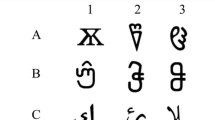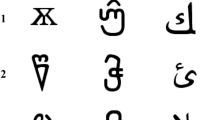Abstract
Variation in baseline controlling relations is suggested as one of the factors determining variability in stimulus equivalence outcomes. This study used single-comparison trials attempting to control such controlling relations. Four children learned AB, BC, and CD conditional discriminations, with 2 samples and 2 comparison stimuli. In Condition A, a mask always covered the S+ or the S−, each in 50% of the training trials, ensuring both sample-S+ and sample-S−controlling relations. In subsequent tests, children showed immediate equivalence formation. Condition B trained the same sequence of conditional discriminations with different stimuli, attempting to prevent sample-S+ control in the BC conditional discrimination. Two children did not show equivalence, whereas the other 2 did. Probes suggested that children who formed equivalence in Condition B acquired sample-S+ relations, even with training designed to prevent them. Results indicate that acquisition of both sample-S+ and sample-S− relations increases the probability of immediate equivalence formation.
Similar content being viewed by others
References
ARNTZEN, E., GRONDAHL, T., & EILIFSEN, C. (2010). The effect of different training structures in the establishment of conditional discriminations and subsequent performance on tests for stimulus equivalence. The Psychological Record, 60, 437–462.
ARNTZEN, E., & HOLTH, P. (1997). Probability of stimulus equivalence as a function of training design. The Psychological Record, 47, 309–320.
BARNES-HOLMES, D., STA UNTON, C., WHELAN, R., BARNES-HOLMES, Y., COMMINS, S., WALSH, D., … DYMOND, S. (2005). Derived stimulus relations, semantic priming, and event-related potentials: Testing a behavioral theory of semantic networks. Journal of the Experimental Analysis of Behavior, 84, 417–433. doi: 10.1901/ jeab.2005.78-04
BORTOLOTI, R., & DE ROSE, J. C. (2009). Assessment of the relatedess of equivalent stimuli through a semantic differential. The Psychological Record, 59, 563–590.
BORTOLOTI, R., & DE ROSE, J. C. (2011). Avaliação do efeito de dica semântica e da indução de significado entre estímulos abstratos equivalentes [Evaluation of the effects of semantic priming and induction of meaning between arbitrary equivalent stimuli]. Psicologia: Reflexão e Crítica, 24, 381–393.
BORTOLOTI, R., & DE ROSE, J. C. (2012). Equivalent stimuli are more strongly related after training with delayed matching than after simultaneous matching: A study using the Implicit Relational Assessment Procedure (IRAP). The Psychological Record, 62, 41–54.
CARRIGAN, P. F. (1986). Conditional discriminations and transitive relations: A theoretical and experimental analysis. Unpublished doctoral dissertation. Northeastern University, Boston.
CARRIGAN, P., & SIDMAN, M. (1992). Conditional discrimination and equivalence relations: A theoretical analysis of control by negative stimuli. Journal of the Experimental Analysis of Behavior, 58, 459–504.
DE ROSE, J. C. (1996). Controlling factors in conditional discriminations and tests of equivalence. In T. R. Zentall & P. M. Smeets (Eds.), Stimulus class formation in humans and animals (pp. 253–277). Amsterdam, The Netherlands: North Holland.
DE ROSE, J. C., DE SOUZA, D. G., & HANNA, E. S. (1996). Teaching reading and spelling: Stimulus equivalence and exclusion. Journal of Applied Behavior Analysis, 29, 451–469.
DEVANY, J. M., HAYES, S. C., & NELSON, R. O. (1986). Equivalence class formation in language-able and language-disabled children. Journal of the Experimental Analysis of Behavior, 46, 243–257.
DUBE, W. V., & HIRIS, J. (1999). Match to Sample Program (Version 11.6.7) [Computer software]. Waltham, MA: E. K. Shriver Center for Mental Retardation.
HAIMSON, B., WILKINSON, K. M., ROSENQUIST, C., OUIMET, C., & MCILVANE, W. J. (2009). Electrophysiological correlates of stimulus equivalence processes. Journal of the Experimental Analysis of Behavior, 92, 245–256. doi: 10.1901/jeab.2009.92-245
HORNE, P. J., & LOWE, C. F. (1996). On the origins of naming and other symbolic behavior. Journal of the Experimental Analysis of Behavior, 65, 185–241.
JOHNSON, C., & SIDMAN, M. (1993). Conditional discrimination and equivalence relations: Control by negative stimuli. Journal of the Experimental Analysis of Behavior, 59, 333–347.
KATO, O. M., DE ROSE, J. C., & FALEIROS, P. B. (2008). Topography of responses in conditional discrimination influences formation of equivalence classes. The Psychological Record, 58, 245–267.
LAZAR, R., DAVIS-LANG, D., & SANCHEZ, L. (1984). The formation of visual stimulus equivalences in children. Journal of the Experimental Analysis of Behavior, 41, 251–266.
MCILVANE, W. J. (2012). Simple and complex discrimination learning. In G. J. Madden (Ed.), APA handbook of behavior analysis (pp. 129–163). Washington, DC: American Psychological Association.
MCILVANE, W. J., & DUBE, W. V. (1992). Stimulus control shaping and stimulus control topographies. The Behavior Analyst, 15, 89–94.
MOSS-LOURENCO, P., & FIELDS, L. (2011). Nodal structure and stimulus relatedness in equivalence classes. Post-class formation preference tests. Journal of the Experimental Analysis of Behavior, 95, 343–368. doi: 10.1901/jeab.2011.95-343
SAUNDERS, K. J., & SPRADLIN, J. E. (1989). Conditional discrimination in mentally retarded adults: The effect of training the component simple discriminations. Journal of the Experimental Analysis of Behavior, 52, 1–12.
PILGRIM, C., JACKSON, J., & GALIZIO, M. (2000). Acquisition of arbitrary conditional discriminations by young normally developing children. Journal of the Experimental Analysis of Behavior, 73, 177–193.
SAUNDERS, R. R., & GREEN, G. (1999). A discrimination analysis of training-structure effects on stimulus equivalence outcomes. Journal of the Experimental Analysis of Behavior, 72, 117–137.
SIDMAN, M. (1986). Functional analysis of emergent verbal classes. In T. Thompson & M. Zeiler (Eds.), Analysis and integration of behavioral units (pp. 213–245). Hillsdale, NJ: Erlbaum.
SIDMAN, M. (1994). Equivalence relations and behavior: A research story. Boston, MA: Authors Cooperative.
SIDMAN, M., KIRK, B., & WILSON-MORRIS, M. (1985). Six-member stimulus classes generated by conditional discrimination procedures. Journal of the Experimental Analysis of Behavior, 43, 21–42.
SIDMAN, M., & TAILBY, W. (1982). Conditional discrimination vs. matching to sample: An expansion of the testing paradigm. Journal of the Experimental Analysis of Behavior, 37, 5–22.
SPRADLIN, J. E., COTTER, V. W., & BAXLEY, N. (1973). Establishing a conditional discrimination without direct training. A study of transfer with retarded adolescents. American Journal of Mental Deficiency, 77, 556–566.
STROMER, R., & OSBORNE, J. G. (1982). Control of adolescents’ arbitrary matching-to- sample by positive and negative stimulus relations. Journal of the Experimental Analysis of Behavior, 37, 329–348. doi: 10.1901/jeab.1982.37-329
WILLIAMS, D. C., SAUNDERS, K. J., SAUNDERS, R. R., & SPRADLIN, J. E. (1995). Unreinforced conditional selection within three-choice conditional discriminations. The Psychological Record, 45, 613–627.
Author information
Authors and Affiliations
Corresponding author
Additional information
Data collection was supported by the State of São Paulo Foundation for Research Support (FAPESP, Grant 2003/09928-4). Preparation of the manuscript was supported by the Brazilian National Research Council (Grant 573972/2008-7) and FAPESP (Grant 08/57705-8), both for the National Institute of Research and Technology on Behavior, Cognition and Teaching (Chairperson: Deisy G. de Souza). The first author has a Research Productivity Grant from CNPq, and the second author had an undergraduate Science Initiation Grant from CNPq.
Rights and permissions
About this article
Cite this article
de Rose, J.C., Hidalgo, M. & Vasconcellos, M. Controlling Relations in Baseline Conditional Discriminations as Determinants of Stimulus Equivalence. Psychol Rec 63, 85–98 (2013). https://doi.org/10.11133/j.tpr.2013.63.1.007
Published:
Issue Date:
DOI: https://doi.org/10.11133/j.tpr.2013.63.1.007




